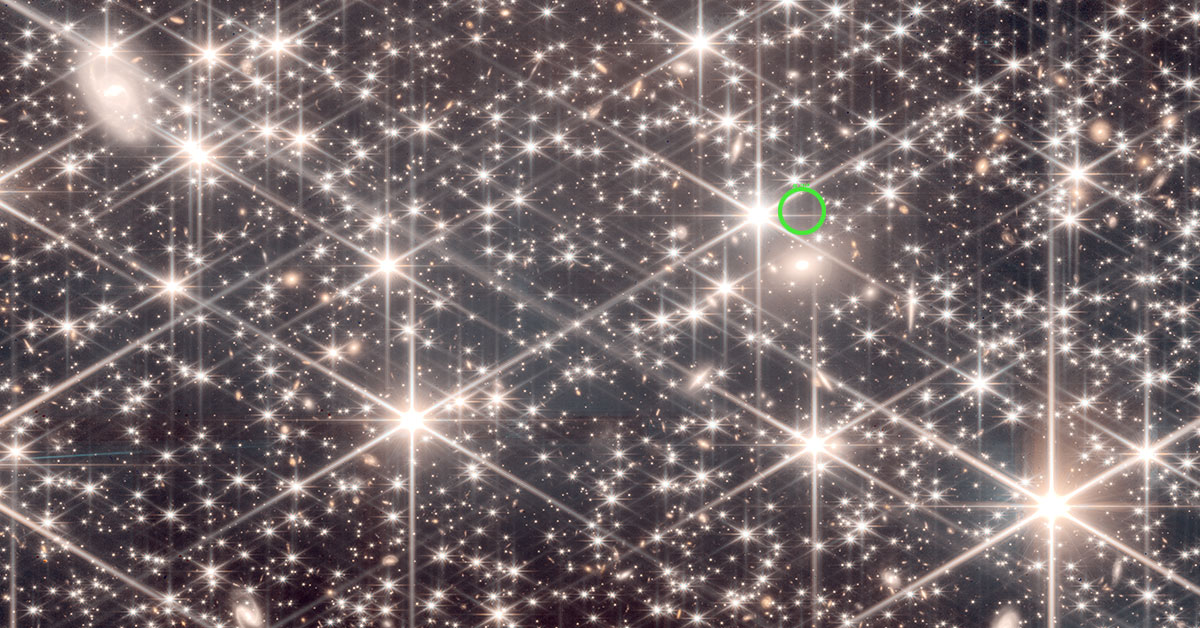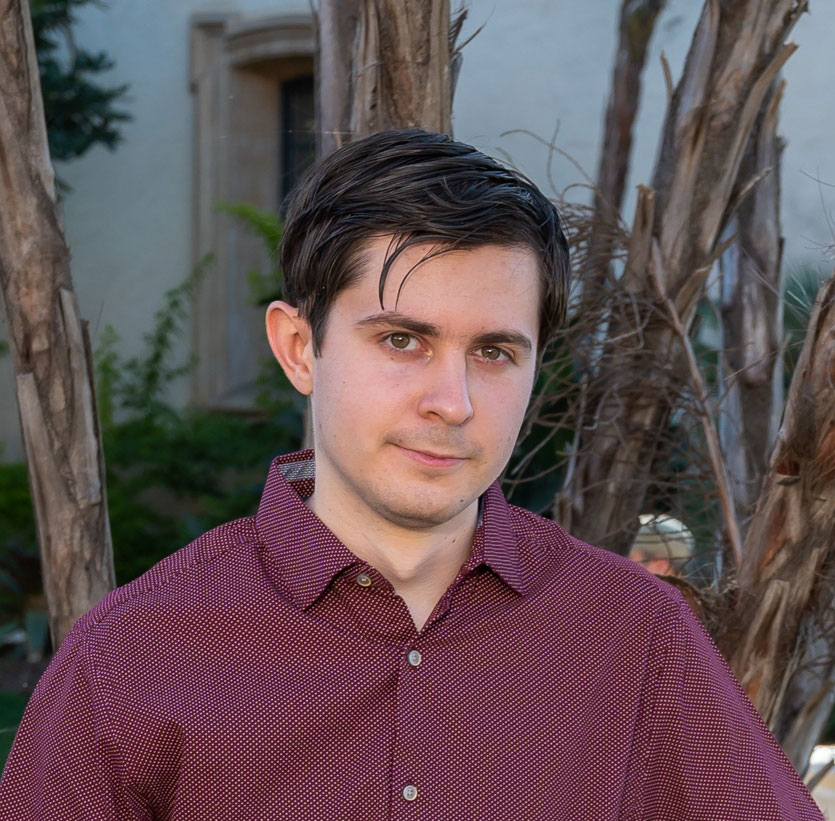News
UC San Diego Doctoral Graduate Recognized for Achievement in Astronomy
Published October 13, 2024
Maryam Abdul-Aziz and Kimberly Mann Bruch, SDSC Communications

As it turns out, brown dwarfs’ uncommon nature makes them valuable when it comes to galactic archeology. Brown dwarfs are neither stars nor planets; rather, they are failed stars, with too little mass to sustain the process of hydrogen fusion. More notably, unlike stars, brown dwarfs cool down and grow fainter as they age, acting as “galactic chronometers” for the Milky Way. These unique properties allow researchers to use them as “galactic chronometers” to observe the development of a galaxy. This image of NGC 6397 was captured by JWST in 2023, in which brown dwarf members were identified for the first time. Credit: James Webb Space Telescope
UC San Diego Alumnus Roman Gerasimov, who recently earned his doctorate from the university, has received the International Astronomical Union (IAU) Stars and Stellar Physics Division Award for outstanding scientific achievement of astronomy. The new Ph.D. scholar attributes much of his success to the Expanse supercomputer at the San Diego Supercomputer Center (SDSC), part of the new School of Computing, Information and Data Sciences at UC San Diego.
“Without ACCESS allocations – like the one on Expanse at SDSC, my research would not have been possible,” said Gerasimov, who is now a postdoctoral researcher at the University of Notre Dame. “In addition to using Expanse, I was also fortunate to have SDSC Director Frank Würthwein on my doctorate committee.”
One of 65 applicants to compete for the IAU award, and one of just nine to receive it, Gerasimov’s winning dissertation was entitled Evolution of Atmospheres and Chemistry of Ancient Stellar Populations. His work focuses on galactic archaeology, and his dissertation included a chemical characterization of the lowest-mass stars in globular clusters. Specifically, he explored how the anomalous chemistry of globular clusters varies between their most massive and least massive members, finding both to be in remarkably close agreement. The finding indicates favorability of models where chemical variations arise as a consequence of multiple generations of star formation.
“The San Diego Supercomputer Center excels in providing access to high-performance computing to accelerate research towards scientific discoveries,” said Würthwein. “Congratulations to Roman for his exemplary work. It was a pleasure serving on his doctorate committee.”
In addition to his thesis work, Gerasimov has been working with a team of Italian astronomers led by Luigi Bedin at l'Institut national d'astrophysique (INAF) to make the first confirmed observation of a brown dwarf in a globular cluster. The team used Expanse along with Bridges-2 at the Pittsburgh Supercomputing Center to detect three of the first confirmed brown dwarfs within a globular cluster of stars. Their work, which was recently published in the Astrophysical Journal, explained how they identified these brown dwarfs as well as their new atmospheric model coined the Spectral ANalog of Dwarfs (SAND) grid.
“Brown dwarfs are similar to stars that you can easily see in the night sky with your naked eye, except that they fade with age so scientists can measure their temperature and determine how old they are,” UC San Diego Professor of Astronomy and Astrophysics Adam Burgasser said. “We used images from the James Webb Space Telescope (JWST) and our ACCESS allocations on Expanse and Bridges-2 to identify and then illustrate the oldest known brown dwarfs with reliable ages.”
To accomplish this, the researchers focused on a specific globular cluster, NGC 6397, to identify brown dwarfs and low-mass stars (collectively referred to as Ultracool Dwarfs [UCDs]). However, they lacked a model detailed enough to fully display all of the atmospheric and chemical intricacies of the UCDs.
 Roman Gerasimov studies galactic archaeology, a field that analyzes the chemical compositions of stars and other astronomical objects in order to learn more about the history of ancient galaxies. “I am trying to understand the process that took the universe from the primordial soup of hydrogen and helium to this incredibly chemically diverse environment that can sustain complicated objects like astronomers,” Gerasimov said at a recent AAS press conference. “In order to do that, I look at very old stars because their chemical composition would capture the very first steps of this process.” Credit: Roman Gerasimov
Roman Gerasimov studies galactic archaeology, a field that analyzes the chemical compositions of stars and other astronomical objects in order to learn more about the history of ancient galaxies. “I am trying to understand the process that took the universe from the primordial soup of hydrogen and helium to this incredibly chemically diverse environment that can sustain complicated objects like astronomers,” Gerasimov said at a recent AAS press conference. “In order to do that, I look at very old stars because their chemical composition would capture the very first steps of this process.” Credit: Roman Gerasimov
“The chemical environments in globular clusters are so unusual that the models that we needed did not exist, and we had to create them from scratch,” Gerasimov explained. “To generate these models, we turned to Efrain Alvarado III, an undergraduate student from UC Berkeley who spent the summer of 2023 at UC San Diego as a visiting researcher. Alvarado used multiple software packages including PHOENIX, ATLAS and MESA to simulate the intricate physics of brown dwarfs and construct models of their spectra.”
Gerasminov said that a major player with his work has been Bedin and his team at INAF, who provided the necessary JWST observations. “With more than 20 years of experience of pushing imagery like the ones from JWST to their limits in order to observe the faintest stars and brown dwarfs in our galaxy, Bedin and his team have been a very important contributor to our work,” Gerasimov said, explaining that it was a combination of ground-breaking sensitivity of JWST and the new models that he and Alvarado computed on Expanse and Bridges-2 that made this discovery possible.
“Our models, the SAND grid, model brown dwarfs within the halo and thick disk of the Milky Way based on Teff, log(g), and chemical composition data with the help of PHOENIX code,” Gerasimov said. “The SAND grid is revolutionary as it fills the gap in low-temperature atmospheric modeling, accurately portraying the metallicity and intricate chemical compositions of UCDs for the first time.”
The grid was published by the team earlier this year and is now available for public use.
Along with the SAND grid, the team also analyzed telescopic imaging of NGC 6397. To determine which objects in a specific region belonged to the globular cluster, they looked at two sets of images from that area, captured nearly 20 years apart: once by the Hubble Space Telescope in 2005 and once by JWST in 2023.
“Up until three years ago, it was extremely difficult to view brown dwarfs in globular clusters because of their faint nature, but with JWST’s cutting-edge power, the impossible became possible,” Burgasser said. “With these observations, we were able to compare the velocities of celestial objects in 2005 and 2023 to determine which UCDs were part of the globular cluster and which were simply ‘imposters’ – those with similar directionality were likely a part of the cluster while the more random objects were not.”
While significantly more brown dwarfs are needed to perform accurate statistics and analysis, Gerasimov, Burgasser, Alvarado and the rest of their team is confident that another image from JWST in just three years will uncover hundreds more.
“Then, we’ll be able to talk about estimating precise ages of globular clusters using this brand new technique, as well as measuring their chemistry at the very low end of the distribution of masses within those objects,” Gerasimov said.
Computational work for this research was funded by the National Science Foundation ACCESS program (grant no. PHY230194).

